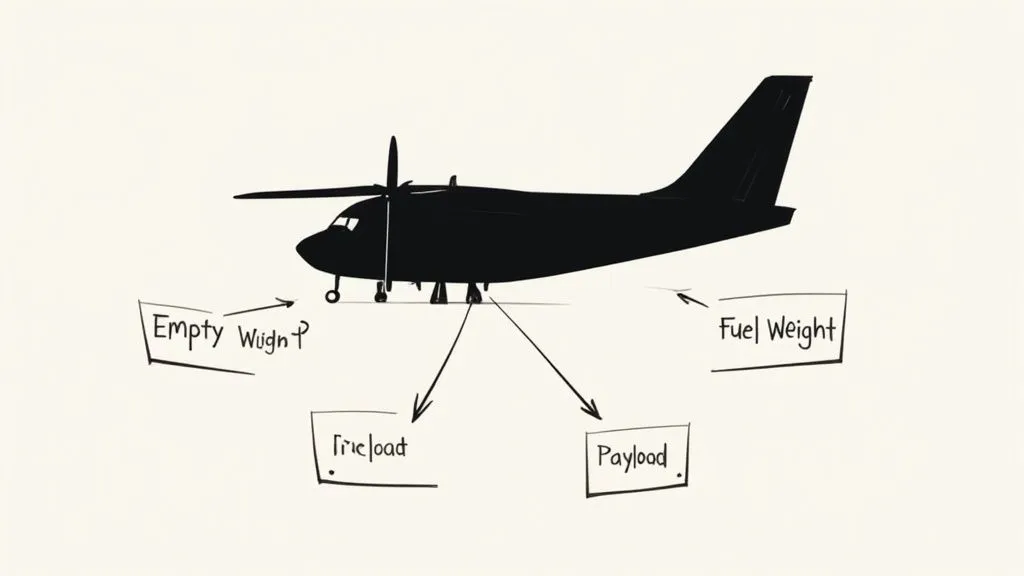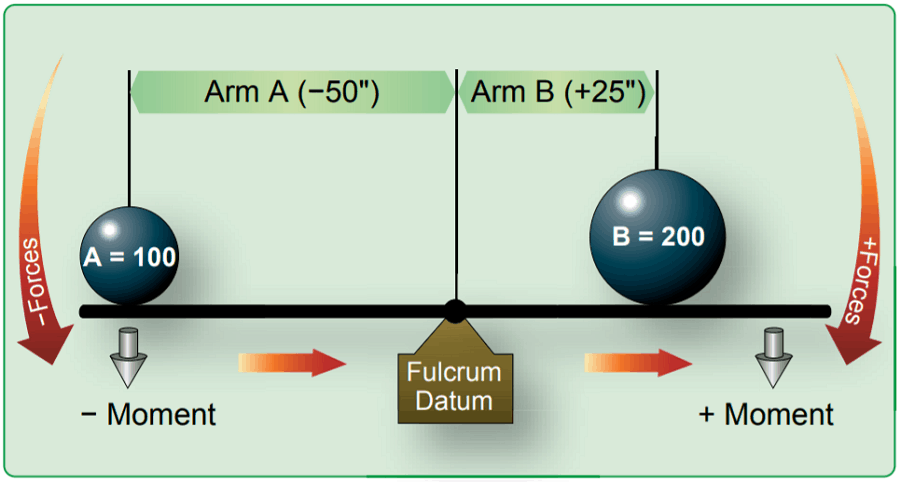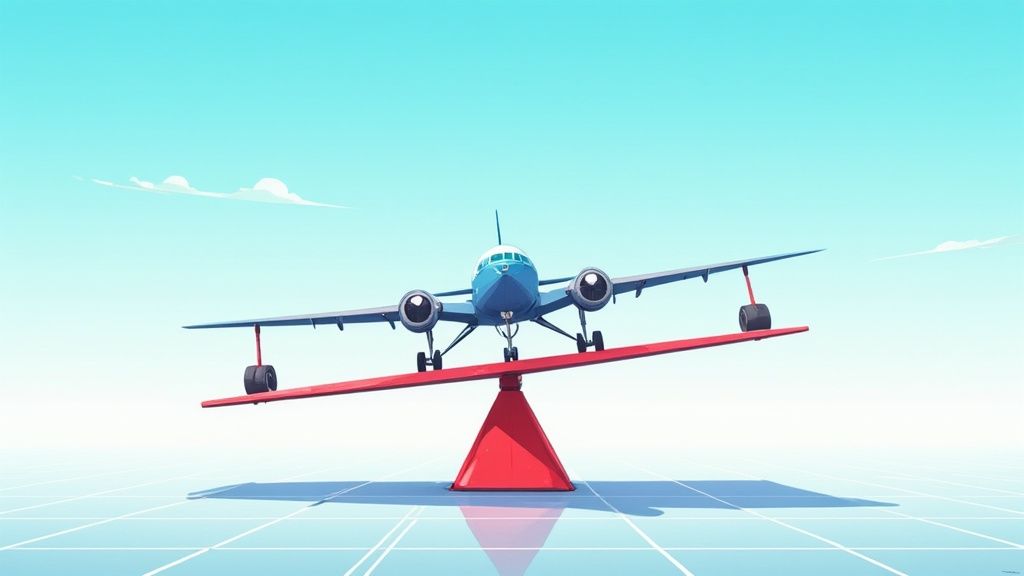The Critical Foundations of Weight and Balance
Aircraft weight and balance calculations are much more than just pre-flight paperwork. They are absolutely fundamental to safe flight. These calculations have a direct impact on your aircraft’s performance and handling, influencing everything from how efficiently it takes off to its overall stability in the air. A solid understanding of weight and balance principles empowers pilots to make informed decisions, leading to fewer unexpected events during flight and a greater margin of safety.
Understanding Key Terminology
Before we delve into the calculations themselves, it’s essential to understand the core terminology. These terms are the foundation upon which we build our understanding of how weight distribution affects an aircraft.
Key Weight and Balance Terminology
Essential terms and definitions that pilots and aviation students need to understand when performing weight and balance calculations
| Term | Definition | Importance |
|---|---|---|
| Empty Weight | The weight of the aircraft without any fuel, passengers, or cargo. This is the aircraft’s baseline weight. | Crucial for determining the total weight of the aircraft and the location of the center of gravity. |
| Payload | The combined weight of passengers, baggage, and cargo. This is the “useful” weight the aircraft carries. | Essential for ensuring the aircraft does not exceed its maximum gross weight and for calculating the center of gravity. |
| Maximum Gross Weight | The absolute maximum weight the aircraft is certified to operate at, including empty weight, payload, and fuel. | Exceeding this limit puts excessive stress on the aircraft’s structure, which can have disastrous consequences. It’s a critical safety limit. |
| Moment | The product of a weight multiplied by its arm. | Used to calculate the center of gravity. |
| Arm | The horizontal distance from the reference datum to the center of gravity of an item. | Used to calculate moments and the center of gravity. |
| Center of Gravity (CG) | The point at which the aircraft would balance if suspended. | A critical factor for aircraft stability and control. Its location must be within specified limits for safe flight. |
This table provides a concise overview of the essential terms used in weight and balance calculations. Understanding these terms is crucial for any pilot.
Read also: Why is weight and balance important in aviation?
The Center of Gravity and Its Importance
The center of gravity (CG) is a crucial concept in weight and balance. It represents the point where the aircraft would perfectly balance if suspended. The CG’s location has a significant impact on the aircraft’s stability and control. A CG that’s too far forward can make the aircraft nose-heavy, while a CG too far aft can create a tail-heavy condition. Both of these situations can negatively impact the aircraft’s handling characteristics.
The fundamental calculation for aircraft weight and balance is based on the principle that the CG is the ratio of moments to weight, expressed mathematically as CG = Moments / Weight. For instance, a calculation might result in a total moment of 281,430 and a total weight of 3,320, leading to a CG of 84.8. This calculation is essential for confirming that the aircraft’s loading falls within safe operational limits. The location of the CG directly affects stability and control.
Practical Implications of Weight and Balance
Understanding how weight distribution affects an aircraft’s flight characteristics is extremely important. A properly balanced aircraft is more fuel-efficient, requires shorter takeoff distances, and exhibits better climb performance. On the other hand, an improperly balanced aircraft might experience reduced range, higher fuel consumption, and compromised handling qualities. These issues can potentially create dangerous flight situations. This is precisely why mastering weight and balance calculations is crucial for all pilots, no matter their level of experience.
Mastering the Weight and Balance Calculation Process
Calculating weight and balance is essential for safe flight. This process ensures the aircraft’s center of gravity (CG) stays within safe limits. A correct CG affects not only performance, but also stability and safety. Let’s explore this critical process step by step.

Gathering the Necessary Information
First, gather the required data from your aircraft’s Pilot Operating Handbook (POH) or Aircraft Flight Manual (AFM). These documents provide the aircraft’s empty weight, the arm for each station (pilot seats, passenger seats, baggage compartments, fuel tanks), and the CG limits. You also need the weight of everyone and everything loaded onto the aircraft. This includes the pilot, passengers, baggage, and fuel.
Having this information organized beforehand makes the calculation process much smoother.
Calculating the Moment
Next, calculate the moment for each item. The moment is the product of an item’s weight and its arm. For instance, if a pilot weighs 170 lbs and the pilot seat arm is 35 inches, the pilot’s moment is 5,950 inch-lbs (170 lbs * 35 inches).
Repeat this calculation for every item on the aircraft, passengers, baggage, and fuel. These individual moments are critical for determining the overall balance.
Determining the Total Moment and Weight
After calculating each individual moment, sum them up to find the total moment. Add all individual weights, including the aircraft’s empty weight, to get the total weight. These two values, total moment and total weight, are crucial for determining the aircraft’s CG.
Calculating the Center of Gravity
Finally, divide the total moment by the total weight to determine the aircraft’s CG. For example, if the total moment is 260,000 inch-lbs and the total weight is 2,500 lbs, the CG is 104 inches (260,000 inch-lbs / 2,500 lbs). Compare this calculated CG to the limits in your aircraft’s POH or AFM. Ensuring the CG is within the acceptable range is vital for safe flight.
For more advanced calculations, learn how to use a flight computer.
Practical Example
To determine if an aircraft is within its weight and CG limits, follow this step-by-step example:
Sample Weight and Balance Calculation
A step-by-step example calculation showing how to determine if an aircraft is within its weight and CG limits
| Component | Weight (lbs) | Arm (inches) | Moment (inch-lbs) |
|---|---|---|---|
| Empty Weight | 1,200 | 35 | 42,000 |
| Pilot | 170 | 35 | 5,950 |
| Passenger | 150 | 70 | 10,500 |
| Baggage | 50 | 90 | 4,500 |
| Fuel (20 gallons) | 120 | 45 | 5,400 |
| Totals | 1,690 | 58,350 |
In this case, the CG is 34.5 inches (58,350 inch-lbs / 1,690 lbs). Always compare this calculated CG against the aircraft’s specific limits. This example shows how each weight affects the aircraft’s overall balance.

Streamlining Calculations and Avoiding Pitfalls
Experienced pilots often use shortcuts to streamline the weight and balance process. However, even seasoned professionals can make mistakes. Common errors include inaccurate weighing, incorrect data entry, or misinterpreting the aircraft documentation. Double-checking calculations and using common sense helps prevent these issues. Being meticulous and practicing with different loading scenarios helps ensure accuracy and safety.
How Weight Estimation Methods Have Transformed Aviation
The methods we use to calculate weight and balance today weren’t always so refined. They’ve evolved significantly, from basic estimations to the precise, engineering-driven calculations we rely on now. Understanding this history gives valuable context to what might otherwise seem like routine pre-flight checks.
The Early Days of Aviation: Trial and Error
In aviation’s infancy, weight estimation was far from an exact science. Aircraft designers depended heavily on experience and intuition, often resorting to trial and error. Imagine constructing a complex machine like an airplane without the precise data and tools available today. Early manufacturers meticulously crafted their own procedures, sometimes with dire consequences if estimations proved inaccurate. This era underscored the critical role of accurate weight and balance in flight safety.
Advances in Materials and Modeling
Over time, major advancements in materials science and computational modeling revolutionized aircraft design. Lighter, stronger materials allowed for more precise construction, directly affecting weight and balance calculations. The development of Computer-Aided Design (CAD) software further empowered engineers to model and analyze aircraft structures with incredible accuracy. The shift from physical prototypes to digital models significantly enhanced the precision of weight estimations, resulting in more reliable weight and balance calculations for pilots.
From Educated Guesses to Engineering Science
Historically, weight estimation methods have continually improved in accuracy and predictive capability. Studies analyzing aircraft design weight estimations for commercial and military aircraft (from the 1940s to the 1970s) found that methods like the FLOPS (Flight Optimization System) could predict weights within approximately 4% of actual zero fuel, operating, and empty weights. More information on historical weight estimations can be found here.
Modern Weight and Balance Calculations: A Legacy of Innovation
Today, weight and balance calculations are essential to pre-flight planning, ensuring aircraft operate within safe parameters. Standardized procedures, detailed aircraft documentation, specialized software, and accessible training resources have simplified the process. However, grasping the historical context behind these calculations emphasizes their importance and prevents complacency. Understanding why we perform these calculations, not just how, makes us safer and more informed aviators. It also highlights the ongoing importance of accurate data and meticulous attention to detail. Every calculation signifies a step forward in aviation safety, built upon lessons learned.
Read also: Aeronautical Decision Making.
Avoiding Career-Defining Weight and Balance Mistakes
Even the most meticulous pilots can fall prey to weight and balance errors. But these critical lessons don’t have to be learned through firsthand experience. By understanding common mistakes and adopting proven verification methods, you can develop solid calculation habits that hold up under pressure.
Learning From Past Incidents
The 2003 Air Midwest Flight 5481 tragedy serves as a stark reminder of the devastating consequences of miscalculations. Overloaded by 580 lbs and with a Center of Gravity (CG) 5% beyond the acceptable limit, the aircraft crashed shortly after takeoff. Stemming from heavier-than-usual luggage and an inaccurate passenger weight estimate, this incident emphasizes the vital importance of accuracy in weight and balance calculations.
Sadly, this isn’t an isolated event. A University of Texas study indicated that aviation accidents related to weight and CG often result in higher fatality rates than those caused by engine failure or other factors. This highlights the critical need for strict adherence to established procedures.
Identifying Calculation Traps
Several factors can lead to weight and balance errors. Inaccurate weighing of passengers and baggage is a frequent culprit. Simple data entry mistakes during calculations can also have significant consequences. Misinterpreting aircraft documentation, like using outdated empty weight figures or incorrectly identifying arm distances, can significantly skew CG calculations. Furthermore, psychological factors, such as overconfidence or complacency, can lead to rushed or skipped calculations.
Practical Verification Techniques
Professional pilots employ various techniques to double-check weight and balance calculations. Cross-checking, where calculations are performed using different methods or reviewed by another pilot, helps catch potential errors. Rule-of-thumb calculations, while not a substitute for complete calculations, offer a quick sanity check. For instance, comparing an estimated CG location based on typical loading scenarios against the calculated value can quickly reveal discrepancies.
Handling Last-Minute Changes
Last-minute adjustments, such as unexpected passengers or cargo shifts, introduce further complexity. Recalculating weight and balance after any such changes, even when time is tight, is essential. Having a pre-established procedure for these situations, including easy access to weight and balance information and a quick reference guide for common scenarios, ensures both accuracy and efficiency.
Read also: 19 Aviation Safety Tips.
Building Resilient Calculation Habits
Developing reliable calculation habits requires consistent practice and a dedication to precision. Regularly reviewing procedures, practicing with diverse loading scenarios, and staying informed about best practices are essential. By prioritizing accuracy and integrating verification techniques into every pre-flight check, pilots can minimize the risk of weight and balance errors, contributing to a safer aviation environment.
Tailoring Your Approach Across Different Aircraft Types
Weight and balance calculations, while grounded in universal principles, demand a specific approach for different aircraft. The core concepts of moment, arm, and center of gravity (CG) remain constant, but their real-world application varies significantly. This requires transitioning pilots to adjust their methods for continued safety and optimal performance.
Fixed-Wing Vs. Rotorcraft: A Tale of Two Stabilities
A key difference emerges when comparing fixed-wing aircraft and rotorcraft. Fixed-wing aircraft depend on inherent aerodynamic stability, heavily influenced by wing design and CG location. Helicopters, however, achieve stability through a complex interaction of rotor blade angles and engine power.
This difference significantly impacts how weight and balance affects handling. For instance, a forward CG might improve stability in a fixed-wing aircraft, but could make a helicopter’s controls overly sensitive. Pilots must grasp the unique characteristics of each aircraft type.

Single-Engine Vs. Multi-Engine Aircraft: Balancing the Load
The number of engines also introduces unique weight and balance factors. In single-engine aircraft, the engine’s weight and position are primary considerations. Multi-engine aircraft add complexity with multiple powerplants and fuel systems.
This requires careful consideration of fuel distribution and its effect on the CG during flight. Multi-engine calculations also account for asymmetrical loading, such as an engine failure. Pilots must be adept at managing these variables.
Small Aircraft and Their Restrictive CG Envelopes
Smaller aircraft, often used for training, typically have tighter CG limits. Their smaller size and lower inertia make them more vulnerable to CG deviations. Even a slight weight shift can dramatically impact stability, requiring precise calculations.
A small addition of weight can easily push the CG outside acceptable limits. This necessitates meticulous pre-flight checks and careful loading procedures.
Large Transport Aircraft: Handling Shifting Cargo
Transport pilots face different challenges due to substantial cargo volume and the possibility of shifting. Careful cargo planning and securing are essential for maintaining a stable CG. They frequently work with complex loading manifests and computerized weight and balance systems.
Load planning software assists in optimizing cargo distribution, minimizing stress on the airframe and ensuring a safe CG.
Decoding Aircraft Documentation: A Transitioning Pilot’s Guide
Another challenge for transitioning pilots is the variation in documentation and reference datum locations. Each manufacturer may present weight and balance information differently, and the reference datum can vary between aircraft models.
This can easily cause confusion. Familiarization with each aircraft’s specific documentation is crucial for accuracy and prevents potentially dangerous misinterpretations.
Practical Tips From Multi-Rated Pilots
Experienced multi-rated pilots stress the importance of reviewing the Pilot Operating Handbook (POH) or Aircraft Flight Manual (AFM). They also recommend practical exercises and scenario-based training to build confidence.
These tips improve a pilot’s adaptability and safety awareness across different aircraft platforms.
Leveraging Digital Tools Without Losing Core Skills
Modern pilots have access to a wealth of digital tools designed to simplify weight and balance calculations. But with so many options available, how do you choose the right one? This section explores popular apps, software, and Electronic Flight Bag (EFB) features, informed by the experiences of pilots who use them every day.
Evaluating Digital Weight and Balance Tools
When evaluating these digital tools, several factors are key. Accuracy is paramount – the tool must consistently produce correct results matching manual calculations and aircraft documentation. A user-friendly interface is also crucial, as a cluttered interface can lead to errors, especially under pressure. Finally, seamless integration with other flight planning resources, like weather briefings and navigation tools, boosts efficiency.
Here are some key features to look for:
- Pre-loaded Aircraft Profiles: Access to pre-configured profiles saves time and reduces data entry errors.
- Customizable Profiles: Adjusting profiles to reflect modifications or specific loading scenarios is crucial for accuracy.
- Automatic Recalculation: Automatic updates after any data changes ensure you’re always working with the latest figures.
- Clear Visualizations: Graphical representations of the CG envelope and loading distribution enhance understanding.
- Offline Functionality: Offline calculation capability is essential for operations in areas with limited or no internet access.
Transitioning Between Digital and Manual Methods
While digital tools offer advantages, maintaining proficiency in manual calculations is essential. This ensures you’re prepared if technology fails. Think of it as your backup navigation system. You might rely on GPS, but chart reading is vital if your electronics malfunction.
Practicing manual calculations keeps your core skills sharp and builds confidence. It also reinforces the principles behind the calculations, helping you spot potential errors in digital outputs.
Verifying Digital Outputs: Essential Cross-Checks
Blindly trusting digital tools is risky. Simple cross-checks can help validate digital results. Comparing the calculated CG location against a rough estimate based on experience can reveal discrepancies.
Occasionally performing the entire calculation manually and comparing it to the digital output can identify systematic errors. This practice encourages a critical mindset when using technology.
When to Go Digital and When to Stick With Manual
Digital tools shine in complex situations involving multiple passengers, varied cargo, or intricate fuel calculations. They save time and minimize errors, particularly with larger aircraft or frequent loading changes.
Fuel Planning Basics From Legal Minimums to Real-World Strategy
However, for simple scenarios, like a solo flight in a familiar aircraft, manual calculations might be faster. The best approach depends on the specific flight and your preferences. Proficiency in both methods ensures flexibility.
Real-World Pilot Perspectives on Digital Tools
Many pilots report increased efficiency and reduced workload when using digital tools. These tools simplify calculations, freeing up mental capacity for other pre-flight tasks.
However, some pilots voice concern about over-reliance on technology. They stress understanding the underlying principles and maintaining manual skills. Finding the right balance is key to safe and efficient operations. One veteran pilot shared, “Digital tools are fantastic for complex scenarios, but I always do a quick manual check for peace of mind.” This highlights the importance of a balanced approach.
The Future of Weight and Balance Calculations
As technology evolves, we can expect even more advanced tools. Features like real-time weight monitoring, automated loading adjustments, and integrated performance predictions are on the horizon.
But no matter how advanced these tools become, the core principles of weight and balance remain constant. Understanding these principles, combined with sound judgment, will always be essential for safe flight.
Recent Posts
FAA MOSAIC Final Rule: What Pilots, Manufacturers, and the Aviation Community Need to Know
Learn how the FAA’s MOSAIC final rule revolutionizes Light-Sport Aircraft certification, expands Sport Pilot privileges, and reshapes general aviation. See what’s changing, when it takes effect,...
Student Pilot Insurance: Essential Coverage for Aspiring Flyers
Discover how student pilot insurance can protect your flying dreams. Get expert tips and coverage options to ensure your safety and peace of mind.


